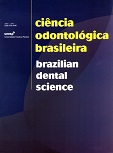Strain Gauge: study of strain distributions around three Morse taper prosthetic connections with offset positioning in machined and plastic copings under vertical load
DOI:
https://doi.org/10.14295/bds.2012.v15i3.823Resumo
The aim of this study was to evaluate through strain gauge the strain distribution occurred around 3 Morse taper implants with positioning offset, by varying the types of copings: plastic and machined. Microunit prosthetic abutments were connected onto the implant platforms. Ten frameworks composed of 3 copings were casted in cobalt-chromium alloy as single block (Co-Cr). Half of the copings were machined (n=5) and half were made of plastics (n=5). Four strain gauges were placed into the polyurethane block tangential to the 3 implants. The frameworks were fixed at their respective sites with the aid of a retaining screw with torque of 20 N.cm, achieve with a mechanical torquemeter. The vertical load of 30 Kg was applied through a spherical point of 2 mm diameter for 10 s, onto each one of the 3 screws of the framework through a device for load application The records of the strain reading were submitted to ANOVA and Tukey tests (5%). There were statistically significant differences (p=0.0174) between the coping type used (machined and plastic). The micro strain mean values were: point C at the machined coping 282.5 ?m (±120.8), point B at the machined coping 229.5 ?m (±76.1), point A at the machined coping 209.8 ?m (±55.0), point C at the plastic coping 155.0 ?m (±30.5), point B at the plastic coping 146.2 ?m (±25.8) and point A at the plastic coping 130.36 ?m (±21.83). It was concluded that there was a significant difference between the coping types, once the plastic coping exerted smaller micro strain on Morse taper implants than the machined copings.
Downloads
Downloads
Arquivos adicionais
Publicado
Como Citar
Edição
Seção
Licença
TRANSFERÊNCIA DE DIREITOS AUTORAIS E DECLARAÇÃO DE RESPONSABILIDADE
Toda a propriedade de direitos autorais do artigo "____________________________________________________________________" é transferido do autor(es) para a CIÊNCIA ODONTOLÓGICA BRASILEIRA, no caso do trabalho ser publicado. O artigo não foi publicado em outro lugar e não foi submetido simultaneamente para publicação em outra revista.
Vimos por meio deste, atestar que trabalho é original e não apresenta dados manipulados, fraude ou plágio. Fizemos contribuição científica significativa para o estudo e estamos cientes dos dados apresentados e de acordo com a versão final do artigo. Assumimos total responsabilidade pelos aspectos éticos do estudo.
Este texto deve ser impresso e assinado por todos os autores. A versão digitalizada deverá ser apresentada como arquivo suplementar durante o processo de submissão.




























